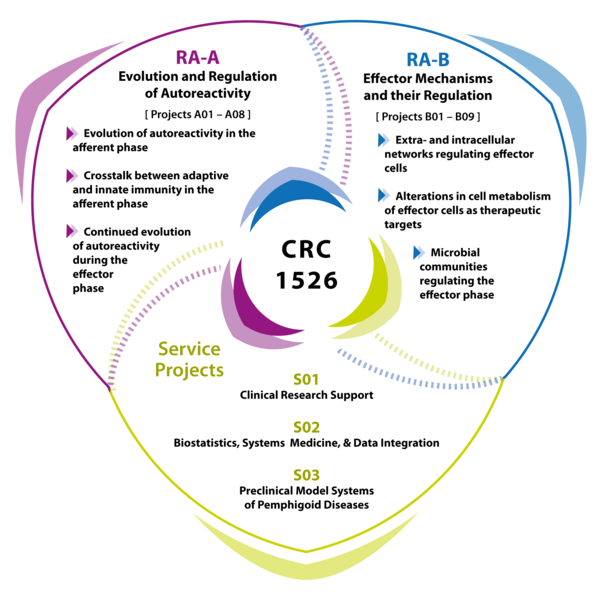Long-term Aims
The overarching long-term aims of the CRC 1526 are:
- Establish new biomarkers for early diagnosis, monitoring, and prediction of treatment responses and outcomes for pemphigoid diseases.
- Develop novel, selective therapeutic strategies for pemphigoid diseases
- Distinguish generic and skin-specific pathogenic pathways in pemphigoid and other autoimmune diseases
By focusing on pemphigoid diseases as paradigm diseases for antibody-driven autoimmune diseases, we will achieve the critical mass to elucidate the pathogenesis of pemphigoid diseases in detail and to accelerate the development of novel, innovative diagnostic, and selective therapeutic strategies for their treatment. The research of the CRC 1526 will be designed to shorten the usually long interval between basic discovery and clinical translation. With the pathogenesis of autoimmune diseases partially depending on generic principles and pathways, our insights into pemphigoid diseases will also significantly advance our understanding of other autoimmune diseases. Furthermore, our insights will be instrumental to develop organ- (skin-)specific therapeutic approaches.
Specific Aims
In its 1st funding period, the CRC 1526 will address two specific aims:
- Delineate the temporal dynamics and mechanisms of the evolution of nonpathogenetic into pathogenic autoimmunity.
- Characterize the transition from pathogenic but clinically inapparent autoimmunity into clinically apparent disease.
The knowledge gained in Specific Aim 1 will be instrumental in improving the early detection of disease and in developing therapeutic approaches disrupting the transition of non-pathogenic into pathogenic autoimmunity. The insights of Specific Aim 2 will be key to develop strategies to selectively disrupt the emergence and maintenance of tissue inflammation.
The CRC 1526 will pursue its specific aims by a research program organized in the Research Area A and Research Area B (Figure 1). The research of both research ares will be supported by the three Service Projects and the Information Infrastructure Project.




